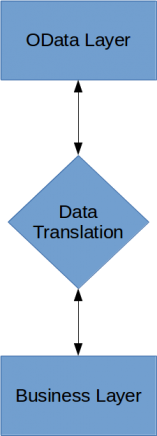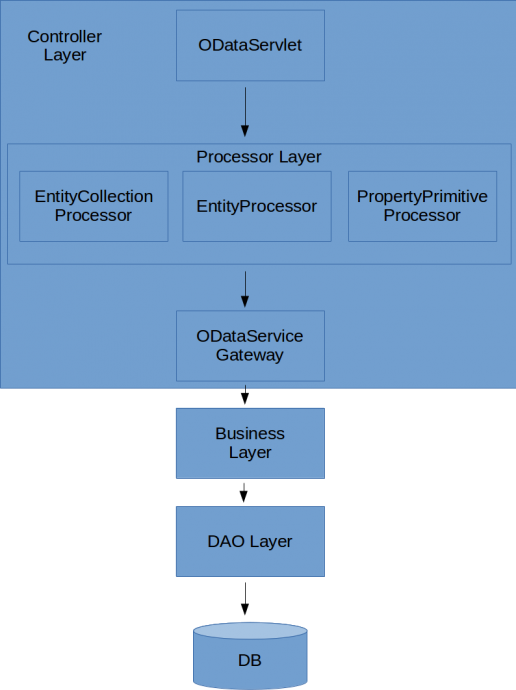Recently I had a chance to spend some time reading about OData and experiment with Apache OLingo Project in order to understand what OData provides us with in terms of making our REST services more standardized and self-discoverable. I also compared it with Spring Data REST Project, what are their similarities and differences, whether it would be meaningful to integrate OLingo with Spring MVC REST, or what should be the scope of integration if possible.
OData is simply a data exchange protocol by definition, and it tries to operate over REST. As it is a data exchange protocol, it first starts with defining a metamodel called as entity data model (EDM). Within EDM, we first specify what are our entities, what attributes they contain, what associations exist between them, functions which can be performed over those entities and so on.
public class PetClinicEdmProvider extends CsdlAbstractEdmProvider {
@Override
public CsdlEntityType getEntityType(FullQualifiedName entityTypeName) throws ODataException {
CsdlEntityType entityType = new CsdlEntityType();
entityType.setName(ENTITY_TYPE_NAME_VET);
CsdlPropertyRef idRef = new CsdlPropertyRef();
idRef.setName("id");
CsdlProperty id = new CsdlProperty().setName("id").setType(EdmPrimitiveTypeKind.Int64.getFullQualifiedName());
CsdlProperty firstName = new CsdlProperty().setName("firstName").setType(EdmPrimitiveTypeKind.String.getFullQualifiedName());
CsdlProperty lastName = new CsdlProperty().setName("lastName").setType(EdmPrimitiveTypeKind.String.getFullQualifiedName());
CsdlProperty graduationYear = new CsdlProperty().setName("graduationYear").setType(EdmPrimitiveTypeKind.Int32.getFullQualifiedName());
entityType.setProperties(Arrays.asList(id,firstName, lastName, graduationYear));
entityType.setKey(Arrays.asList(idRef));
CsdlNavigationProperty navigationProperty = new CsdlNavigationProperty();
navigationProperty.setName("Specialties"); //name of the navigation property
navigationProperty.setType(FQN_ENTITY_TYPE_SPECIALTY);
navigationProperty.setNullable(false);
navigationProperty.setCollection(true);
navigationProperty.setPartner("Vets");
entityType.setNavigationProperties(Arrays.asList(navigationProperty));
return entityType;
}
}
After creating EDM, it comes to write Processor objects to expose data and handle navigations between entities, perform
CRUD operations or other functions/actions and data filtering through REST. We can easily say that Processor objects
closely correspond with RestController beans in Spring MVC REST. They handle incoming web requests, extract information
out of it, and translate that OData specific information into a format so that the current task can be delegated to the
business layer. After the business layer returns, this time domain specific result data is translated back into the OData
format and the web response is generated by writing it as the HTTP response body. That translator part, as depicted in
the following diagram, is called as OData service gateway or gateway in short. It acts as a bridge between processor and
service layers.
public class PetClinicEntityProcessor implements EntityProcessor {
@Override
public void readEntity(ODataRequest request, ODataResponse response, UriInfo uriInfo, ContentType responseFormat)
throws ODataApplicationException, ODataLibraryException {
// extract metadata from request uri
List resourceParts = uriInfo.getUriResourceParts();
UriResource uriResource = resourceParts.get(0);
UriResourceEntitySet resourceEntitySet = (UriResourceEntitySet) uriResource;
EdmEntitySet edmEntitySet = resourceEntitySet.getEntitySet();
// extract query data from request uri to perform search
List keyPredicates = resourceEntitySet.getKeyPredicates();
// execute backend business logic, search for specific entity in this
// case
Entity entity = oDataServiceGateway.readEntity(edmEntitySet, keyPredicates);
// create a serializer to serialize found entity
ContextURL contextUrl = ContextURL.with().entitySet(edmEntitySet).build();
EntitySerializerOptions options = EntitySerializerOptions.with().contextURL(contextUrl).build();
ODataSerializer serializer = odata.createSerializer(responseFormat);
SerializerResult result = serializer.entity(serviceMetadata, resourceEntitySet.getEntityType(), entity,
options);
// write serialized data into the response
response.setContent(result.getContent());
response.setStatusCode(HttpStatusCode.OK.getStatusCode());
response.setHeader(HttpHeader.CONTENT_TYPE, responseFormat.toContentTypeString());
}
}

Finally, you need to write an ODataServlet in which you bring those pieces together and handle the current web request.
ODataServlet, Processors and OData service gateway can be seen as composing a Controller layer altogether.
public class ODataServlet extends HttpServlet {
private PetClinicService petClinicService = new PetClinicServiceImpl(new PetClinicDaoInMemoryImpl());
@Override
protected void service(HttpServletRequest request, HttpServletResponse response) throws ServletException, IOException {
OData oData = OData.newInstance();
ServiceMetadata serviceMetadata = oData.createServiceMetadata(new PetClinicEdmProvider(), new ArrayList<>());
ODataHttpHandler handler = oData.createHandler(serviceMetadata);
ODataServiceGateway oDataServiceGateway = new ODataServiceGateway(petClinicService);
PetClinicEntityCollectionProcessor entityCollectionProcessor = new PetClinicEntityCollectionProcessor(oDataServiceGateway);
PetClinicEntityProcessor entityProcessor = new PetClinicEntityProcessor(oDataServiceGateway);
PetClinicPropertyPrimitiveProcessor propertyPrimitiveProcessor = new PetClinicPropertyPrimitiveProcessor(oDataServiceGateway);
//handler.register(new DefaultDebugSupport());
handler.register(entityCollectionProcessor);
handler.register(entityProcessor);
handler.register(propertyPrimitiveProcessor);
handler.process(request, response);
}
}

The end result is just exposing domain/data model over REST in a standard format/structure. OData specification tries to act similar to WSDL/SOAP of the REST world. We can actually say that OData is WSDL/SOAP of REST. In my experience, it seems that as WSDL/SOAP makes things too complex in XML-based web services, the same is true for OData in the REST side, too. Although, it will help you expose your domain/data model in a standard format, and make it exchangeable among various clients and servers, if your expectation from OData is just to create a standard REST API for accessing data, and performing operations over that REST API, OData will simply be an overkill.
Spring Data REST and OData/OLingo are competitors in short. They both are trying to achieve similar results but from
completely different perspectives. As OData is totally data centric or data oriented, Spring Data REST, on the other hand,
is function oriented. It would be meaningless trying to integrate OData/OLingo with Spring Data REST or Spring MVC REST,
so that Spring should totally be responsible in handling web requests, and operating on the controller layer. OData as a
protocol, and Apache OLingo as the implementation of it should be in complete control in handling web requests. However,
OLingo can be integrated with Spring and leverage Spring Container’s capabilities in a limited fashion. ODataServlet
can be replaced with a Spring Controller which just handles any HTTP request and delivers it to OData Handler for further
processing. In that scenario, HTTP response is not written by Spring at all. OData service gateway can be made a
Spring-managed bean as well. That way, Spring managed service beans can easily be injected into it.
@Controller
public class PetClinicODataController {
@Autowired
private PetClinicService petClinicService;
@RequestMapping
public void handle(HttpServletRequest request, HttpServletResponse response) {
//OData instance must be unique for each request/thread
OData oData = OData.newInstance();
ServiceMetadata serviceMetadata = oData.createServiceMetadata(new PetClinicEdmProvider(), new ArrayList<>());
ODataHttpHandler handler = oData.createHandler(serviceMetadata);
ODataServiceGateway oDataServiceGateway = new ODataServiceGateway(petClinicService);
PetClinicEntityCollectionProcessor entityCollectionProcessor = new PetClinicEntityCollectionProcessor(oDataServiceGateway);
PetClinicEntityProcessor entityProcessor = new PetClinicEntityProcessor(oDataServiceGateway);
PetClinicPropertyPrimitiveProcessor propertyPrimitiveProcessor = new PetClinicPropertyPrimitiveProcessor(oDataServiceGateway);
handler.register(new DefaultDebugSupport());
handler.register(entityCollectionProcessor);
handler.register(entityProcessor);
handler.register(propertyPrimitiveProcessor);
handler.process(request, response);
}
}
Spring Data REST’s choice to make REST API standardized and self discoverable is HATEOAS. Hypertext as the engine of application state is an approach so that clients should be able to discover REST API by themselves via following HTML link tags returned from REST service calls. However, even with HATEOAS, everything is not explicitly defined and self discoverable by client applications without any external help. It is still needed for someone who will interpret returned links and prepare upcoming REST calls out of those link information. On the other hand, it is necessary to have a standardized approach or style applied throughout a REST API. That way, client-side developers will easily understand and learn how to fetch, insert, update, or delete data.